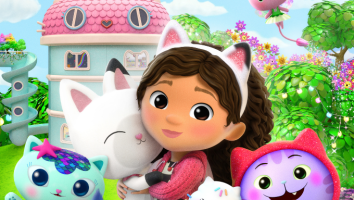By: Christopher Byrne
It may be a relative newcomer, but Gabby’s Dollhouse already looks like a major, long-term success—and a merchandising powerhouse.
Produced by DreamWorks Animation Television, the preschool series launched on Netfix in 2021, followed shortly after by a line of licensed products from Spin Master. A year later, The Hollywood Reporter called Gabby’s Dollhouse “a sleeper hit.”
According to retail sales data from consumer behavior researcher Circana, Gabby’s Dollhouse was the number-two preschool toy license in the US for YTD in September 2023. The show’s seamless integration of programming and play is key to the merchandise’s success, confirming that narrative is one of the most powerful components driving a licensed toy line.
Kidscreen sat down with Doug Wadleigh, EVP of global brands for Spin Master, to gab about all things Gabby and what’s made it such a hit—both as an entertainment brand and as a platform for toys and play.
Kidscreen: What is it about the show—and the story—that has made Gabby’s Dollhouse so toyetic?
Doug Wadleigh: Gabby’s Dollhouse is extraordinary. It’s a toymaker’s dream come to life. First, it has traditional dollhouse play, complete with everything that we know works in dollhouses—features such as great rooms, elevators and slides.
It also has a highly aspirational element that really fosters imagination. A real girl gets transformed and transported into the dollhouse. Once she’s there, there are so many different things to do. And it’s got an unbelievably cute aesthetic.
There’s whimsy in the world, from the music to everything being “cat-ifed.” Everything about the aesthetic is also happy, including the colors, the design of the characters, and the attention to detail. When we set up the galleries at Toy Fair, if you were down in the dumps, you could just go look at the product and it always picked you up.
There is so much going on in the show. Outside of the obvious things like the dollhouse, how do you approach developing toys that reflect Gabby’s world, while providing lots of room for kids to imagine and build their own narratives?
It started with a strong idea from DreamWorks to anchor everything in the Dollhouse, and we have a great team as well at Spin Master Entertainment. What we do before every season is have collaboration sessions. Where can Gabby go? What new place can we create? How does she get there? And what’s in the secret attic?
DreamWorks is open to hearing our ideas. At the end of the day, it’s their show and their IP, and they can do what they like, but they do solicit our ideas—and every once in a while, we get a hit. For instance, we ideated Gabby’s Dollhouse Cruise Ship two years ago…and they [incorporated] it.
It’s a real change in the approach to licensing. I’ve been doing this a really long time, and it can be difficult to have that kind of collaborative relationship.
For kids shows, having a toy line as part of that pitch is no longer a “nice to have,” it’s a “need to have.” What advice would you give creative folks developing their IPs and trying to attract a toy company?
First and foremost, if you think you have the recipe for success, you’re wrong. There is no magic recipe. For toy companies, there will always be something you pick that won’t work, and something you pass on that will.
What we look for are classic, traditional play patterns that have been around for decades. It’s important that the storylines and characters are aspirational for both boys and girls. We look for rich, robust storytelling, characters that kids find compelling, and deep worlds they want to immerse themselves in.
You also have to have a hook that’s unique and different—live action or animation. For Gabby, it was the aesthetic…and overloading it with cats. You have to look for the opportunities to merchandise and give kids a way to play out those stories, as well as create their own.
This story originally appeared in Kidscreen’s February/March 2024 magazine issue.






















